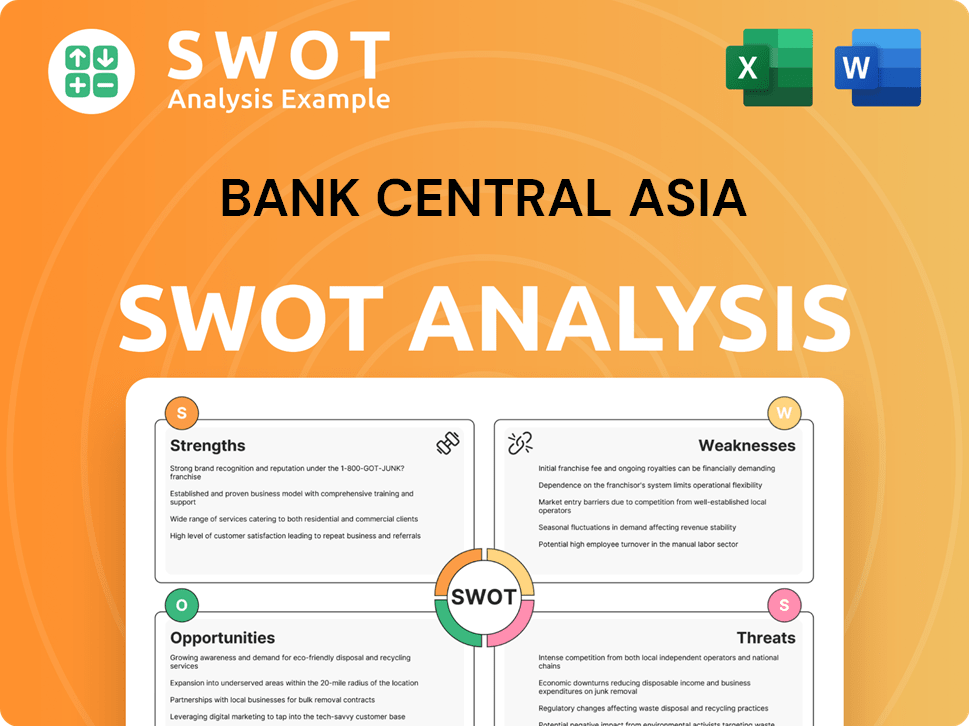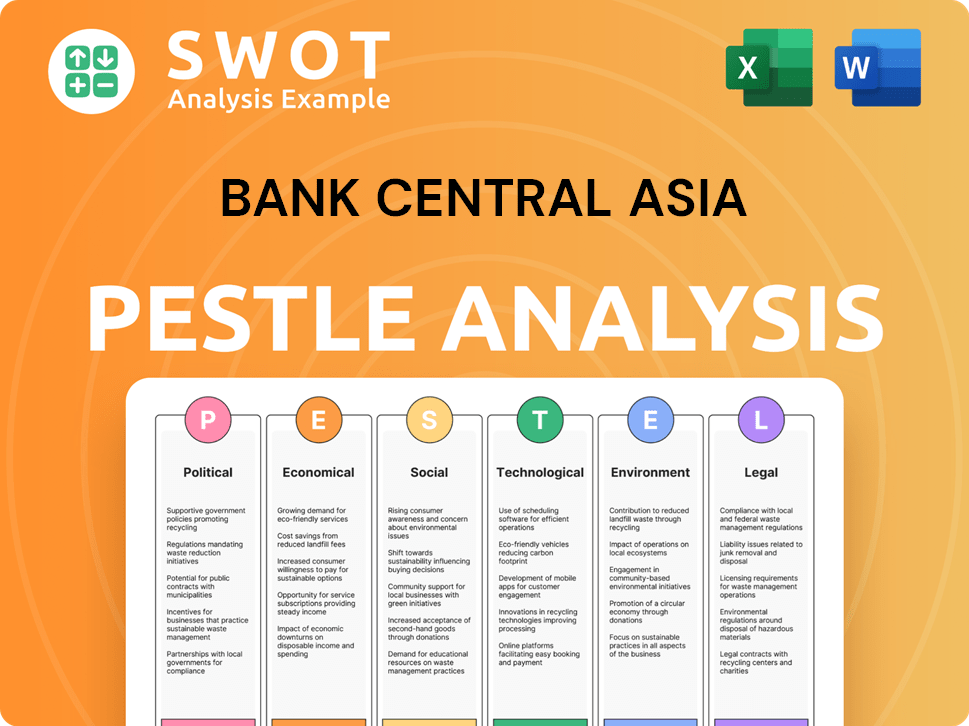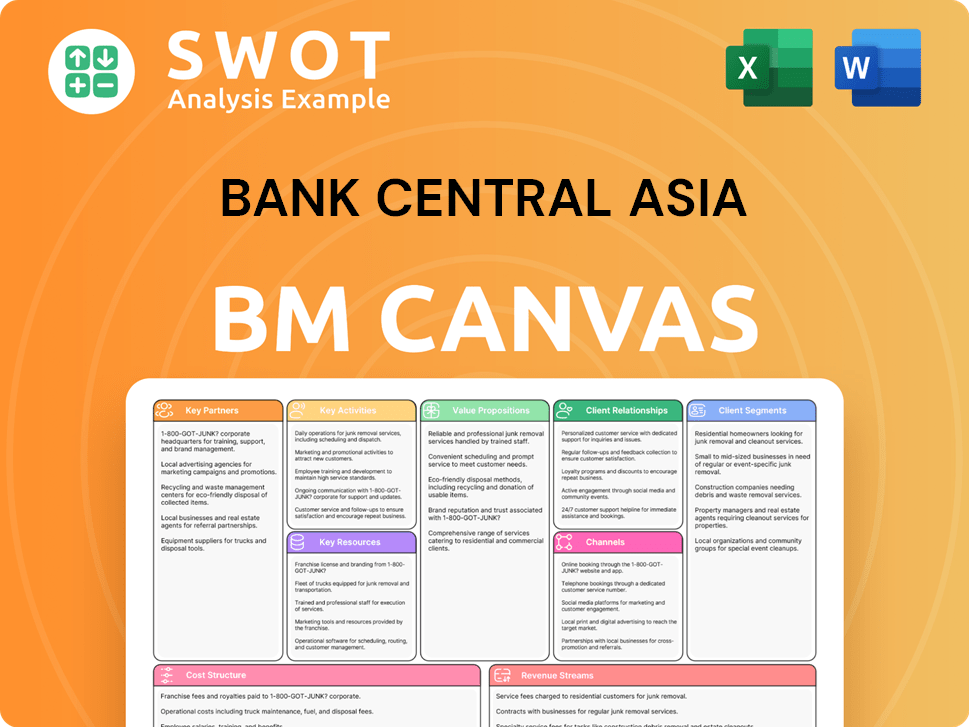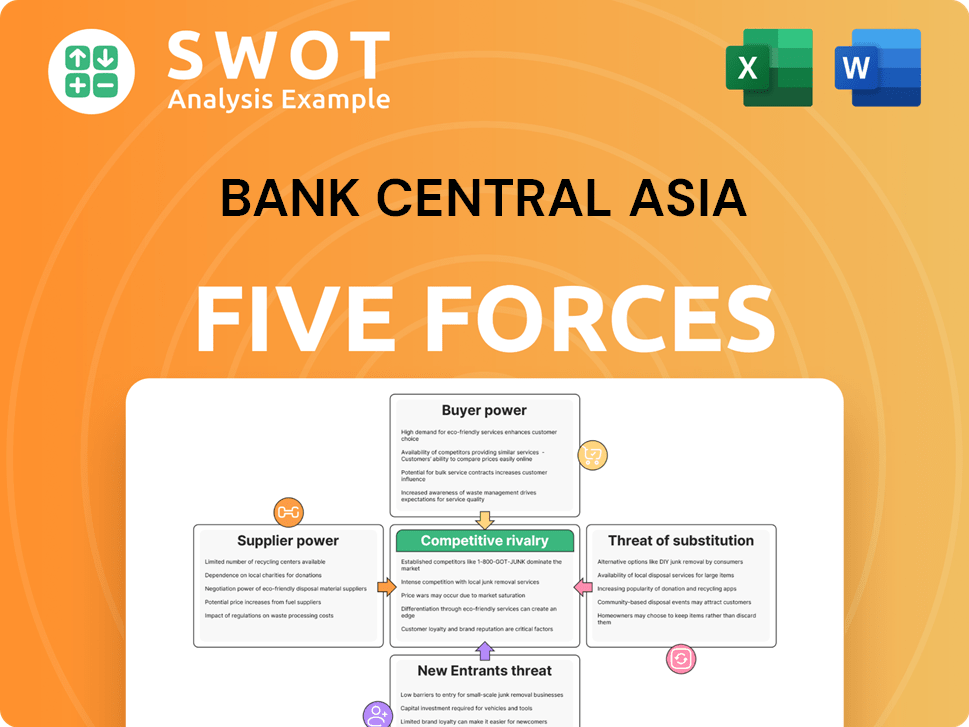Bank Central Asia Bundle
Who Really Owns Bank Central Asia?
The ownership structure of a company is a critical determinant of its strategic direction, influence, and accountability. Bank Central Asia (BCA), a leading Indonesian bank, has a fascinating ownership history, shaped by the 1997 Asian financial crisis. Understanding who owns BCA is key to grasping its market performance and long-term viability. This analysis dives into the evolution of BCA's ownership.

From its origins with the Salim Group to its current status as a financial powerhouse, the Bank Central Asia SWOT Analysis reveals a story of resilience and adaptation. Exploring the "BCA ownership" landscape provides crucial insights into the Indonesian financial sector. This examination will cover the "Bank Central Asia owner," the "BCA company," and the "Bank Central Asia shareholders," shedding light on the key investors and the major stakeholders that have shaped BCA's success. Discover the intricacies of "Indonesian bank ownership" and uncover the answers to questions like "Who owns BCA" and "Who is the majority shareholder of Bank Central Asia."
Who Founded Bank Central Asia?
The genesis of Bank Central Asia (BCA) traces back to 1955, initially established as 'NV Perseroan Dagang Dan Industrie Semarang Knitting Factory' by the Salim Group. The bank commenced operations on February 21, 1957. The Salim Group's foundational role marks the initial ownership of the company.
Mochtar Riady significantly influenced BCA's trajectory, taking control and driving its rapid expansion during the 1980s and 1990s. While specific equity splits at the outset are not publicly detailed, the Salim Group's establishment of the entity underscores their initial ownership stake. This early phase set the stage for BCA's future growth.
During its formative years, BCA focused on expanding its branch network and developing its technological capabilities. This included establishing an online system and introducing new products, such as the Tahapan BCA savings accounts. The installation of ATMs in Jakarta in 1991 marked a significant technological advancement.
The Salim Group founded BCA in 1955, establishing the initial ownership structure.
Mochtar Riady played a pivotal role in BCA's expansion during the 1980s and 1990s.
BCA invested in technology, including online systems and ATMs, to enhance its services.
BCA aggressively expanded its branch network to align with the deregulation of the Indonesian banking sector.
The introduction of products like Tahapan BCA savings accounts marked early product diversification.
In 1991, BCA installed 50 ATMs in Jakarta, a significant step in its technological development.
Information regarding early backers, angel investors, and specific shareholding percentages during the initial phases of BCA is not readily available. Understanding the initial ownership structure is crucial for analyzing the bank's evolution. To learn more about the company's future, you can read about the Growth Strategy of Bank Central Asia.
- The Salim Group's foundational role signifies the initial ownership.
- Mochtar Riady's influence was critical in the bank's expansion.
- Early technological advancements included online systems and ATMs.
- BCA focused on branch network expansion and new product development.
Bank Central Asia SWOT Analysis
- Complete SWOT Breakdown
- Fully Customizable
- Editable in Excel & Word
- Professional Formatting
- Investor-Ready Format

How Has Bank Central Asia’s Ownership Changed Over Time?
The ownership of Bank Central Asia (BCA) has seen major changes, especially after the 1997 Asian financial crisis. In 1998, following a bank run, the Indonesian Bank Restructuring Agency (IBRA), a government entity, took over BCA. This was part of a plan to fix and recapitalize the bank. By 1999, the Indonesian government, through IBRA, owned 92.8% of BCA's shares.
BCA went public on May 31, 2000, with an Initial Public Offering (IPO), where IBRA sold 22.5% of its shares, reducing its stake to 70.3%. Further public offerings in 2001 decreased IBRA's ownership to 60.3%. A significant shift occurred in 2002 when FarIndo Investment (Mauritius) Limited acquired 51% of BCA's shares. By 2005, the government had completely divested its remaining shares, ending government ownership.
| Year | Event | Impact on Ownership |
|---|---|---|
| 1998 | IBRA Takeover | Government ownership initiated |
| 2000 | IPO | IBRA's stake reduced to 70.3% |
| 2002 | FarIndo Investment Acquisition | Shift to private ownership control |
| 2005 | Government Divestment | End of government ownership |
Currently, the majority shareholder of BCA is PT Dwimuria Investama Andalan, holding 54.94% of the shares as of December 31, 2024. The ultimate owners of PT Dwimuria Investama Andalan are Mr. Robert Budi Hartono and Mr. Bambang Hartono. Public shareholders hold 45.06% of the shares as of December 2024. Other significant institutional holders include The Vanguard Group, Inc. (1.21% as of December 30, 2024), Capital Research and Management Company (1.00% as of March 30, 2025), and Norges Bank Investment Management (0.96% as of June 29, 2024). This structure shows strong control by the Djarum Group, an Indonesian conglomerate. To understand the competitive environment, consider the Competitors Landscape of Bank Central Asia.
The ownership of BCA has evolved significantly from government control to private ownership.
- The Djarum Group, through PT Dwimuria Investama Andalan, is the majority shareholder.
- Public shareholders hold a substantial portion of the shares.
- Institutional investors also have significant stakes in the bank.
- The ownership structure reflects a transition from state control to private enterprise.
Bank Central Asia PESTLE Analysis
- Covers All 6 PESTLE Categories
- No Research Needed – Save Hours of Work
- Built by Experts, Trusted by Consultants
- Instant Download, Ready to Use
- 100% Editable, Fully Customizable

Who Sits on Bank Central Asia’s Board?
The governance of Bank Central Asia (BCA) is significantly shaped by its Board of Directors and Board of Commissioners. As of December 31, 2024, the combined ownership of BCA shares by the Board of Commissioners and Directors was at 0.14%. This structure is crucial in understanding the dynamics of BCA ownership and the influence of key stakeholders. The recent changes in leadership further highlight the evolving landscape of the company's governance.
The Annual General Meeting of Shareholders (AGMS) on March 25, 2025, saw proposed changes to the Board of Commissioners and Directors. Jahja Setiaatmadja was proposed to transition from President Director to President Commissioner, replacing Djohan Emir Setijoso. Gregory Hendra Lembong was nominated as President Director, with John Kosasih becoming Deputy President Director and Hendra Tanumihardja appointed as a Director. These appointments were subject to approval from the Financial Services Authority (OJK). The General Meeting of Shareholders (GMS) on March 12, 2025, formally approved these strategic changes, with Jahja Setiaatmadja and Gregory Hendra Lembong assuming their new roles.
| Position | Name | Date of Appointment (2025) |
|---|---|---|
| President Commissioner | Jahja Setiaatmadja | March 12 |
| President Director | Gregory Hendra Lembong | March 12 |
| Deputy President Director | John Kosasih | Proposed March 25 |
Given that PT Dwimuria Investama Andalan held 54.94% of the shares as of December 31, 2024, it is clear that this entity, and by extension, its ultimate shareholders, Mr. Robert Budi Hartono and Mr. Bambang Hartono, wield considerable voting power. This substantial ownership stake is a key factor in understanding Revenue Streams & Business Model of Bank Central Asia and the overall control of the bank. There have been no recent reports of proxy battles or governance controversies.
Understanding the ownership structure of Bank Central Asia is key to grasping its governance. The majority shareholder significantly influences decision-making.
- PT Dwimuria Investama Andalan held 54.94% of shares as of December 31, 2024.
- The Board of Commissioners and Directors owned 0.14% of BCA shares as of December 31, 2024.
- Recent leadership changes were approved at the AGMS and GMS in March 2025.
- The Hartono brothers, as ultimate shareholders, have considerable influence.
Bank Central Asia Business Model Canvas
- Complete 9-Block Business Model Canvas
- Effortlessly Communicate Your Business Strategy
- Investor-Ready BMC Format
- 100% Editable and Customizable
- Clear and Structured Layout

What Recent Changes Have Shaped Bank Central Asia’s Ownership Landscape?
Over the past three to five years, the ownership structure of Bank Central Asia (BCA) has remained relatively stable. The controlling shareholder is PT Dwimuria Investama Andalan, holding a significant stake. As of December 31, 2024, this entity held a 54.94% stake in the company. The ultimate shareholders of PT Dwimuria Investama Andalan are Mr. Robert Budi Hartono and Mr. Bambang Hartono. Public shareholders collectively hold 45.06% of the shares as of December 2024.
In 2024, BCA announced a share buyback program valued at Rp1 trillion (approximately US$62.5 million), initiated in mid-April. While the short-term impact on stock movements was deemed minor, the management emphasized its focus on enhancing financial performance. Key performance indicators include profitability, return on assets, return on equity, the cost-to-income ratio, and asset quality. These factors are crucial for maintaining investor confidence and driving long-term value. For further insights into the bank's strategic positioning, you can explore the Target Market of Bank Central Asia.
| Key Ownership Details | As of December 31, 2024 | Notes |
|---|---|---|
| PT Dwimuria Investama Andalan | 54.94% | Controlling Shareholder; Ultimate shareholders: Mr. Robert Budi Hartono and Mr. Bambang Hartono |
| Public Shareholders | 45.06% | Includes various institutional and individual investors |
| Share Buyback Program | Rp1 trillion (US$62.5 million) | Initiated in mid-April 2024 |
Leadership changes were also a recent focus. At the Annual General Meeting of Shareholders (AGMS) on March 25, 2025, several appointments were approved. Jahja Setiaatmadja transitioned from President Director to President Commissioner. Gregory Hendra Lembong was appointed as the new President Director, with John Kosasih as Deputy President Director, and Hendra Tanumihardja as a Director. These changes are part of BCA's succession planning to ensure continuity and growth. The bank continues to invest in digital banking solutions and has a venture capital arm, Central Capital Ventura, which received a 400 billion rupiah (around US$27.8 million) allocation in 2022 to invest in fintech startups.
The ownership of BCA is primarily controlled by PT Dwimuria Investama Andalan. Public shareholders hold a significant portion of the remaining shares. The ultimate beneficiaries are Mr. Robert Budi Hartono and Mr. Bambang Hartono.
BCA initiated a share buyback program in mid-April 2024, valued at Rp1 trillion. The program reflects the bank's commitment to enhancing shareholder value. The focus remains on strengthening financial performance.
Recent changes in leadership were approved at the AGMS on March 25, 2025. Jahja Setiaatmadja moved to President Commissioner. Gregory Hendra Lembong is the new President Director.
BCA's ownership profile aligns with increased institutional ownership in the banking sector. The bank continues to invest in digital banking solutions. Central Capital Ventura received a 400 billion rupiah allocation in 2022.
Bank Central Asia Porter's Five Forces Analysis
- Covers All 5 Competitive Forces in Detail
- Structured for Consultants, Students, and Founders
- 100% Editable in Microsoft Word & Excel
- Instant Digital Download – Use Immediately
- Compatible with Mac & PC – Fully Unlocked

Related Blogs
- What are Mission Vision & Core Values of Bank Central Asia Company?
- What is Competitive Landscape of Bank Central Asia Company?
- What is Growth Strategy and Future Prospects of Bank Central Asia Company?
- How Does Bank Central Asia Company Work?
- What is Sales and Marketing Strategy of Bank Central Asia Company?
- What is Brief History of Bank Central Asia Company?
- What is Customer Demographics and Target Market of Bank Central Asia Company?
Disclaimer
All information, articles, and product details provided on this website are for general informational and educational purposes only. We do not claim any ownership over, nor do we intend to infringe upon, any trademarks, copyrights, logos, brand names, or other intellectual property mentioned or depicted on this site. Such intellectual property remains the property of its respective owners, and any references here are made solely for identification or informational purposes, without implying any affiliation, endorsement, or partnership.
We make no representations or warranties, express or implied, regarding the accuracy, completeness, or suitability of any content or products presented. Nothing on this website should be construed as legal, tax, investment, financial, medical, or other professional advice. In addition, no part of this site—including articles or product references—constitutes a solicitation, recommendation, endorsement, advertisement, or offer to buy or sell any securities, franchises, or other financial instruments, particularly in jurisdictions where such activity would be unlawful.
All content is of a general nature and may not address the specific circumstances of any individual or entity. It is not a substitute for professional advice or services. Any actions you take based on the information provided here are strictly at your own risk. You accept full responsibility for any decisions or outcomes arising from your use of this website and agree to release us from any liability in connection with your use of, or reliance upon, the content or products found herein.